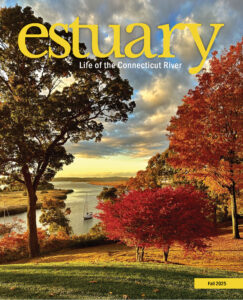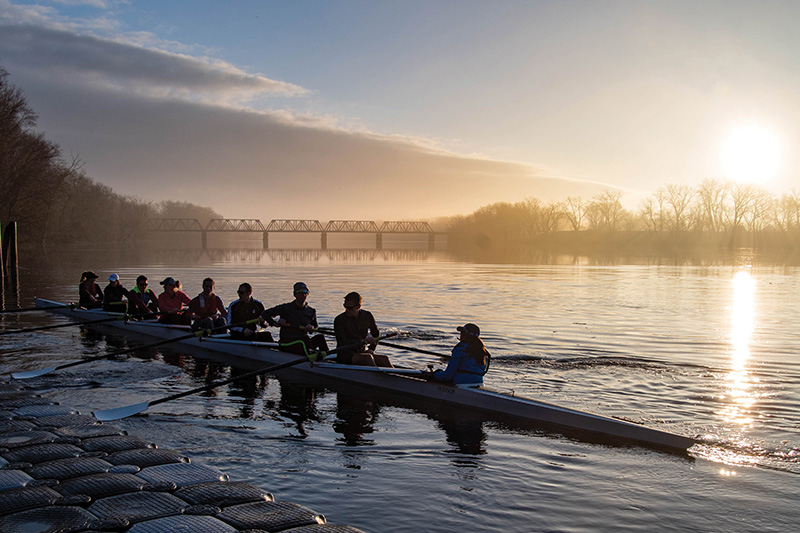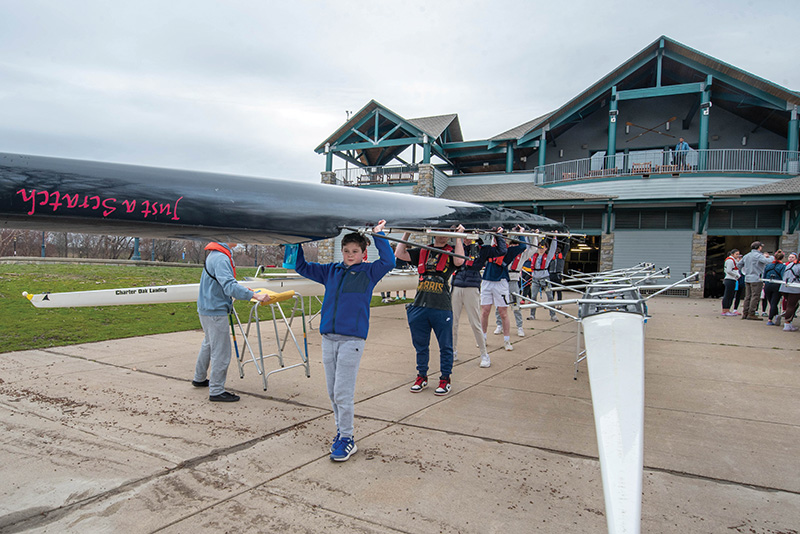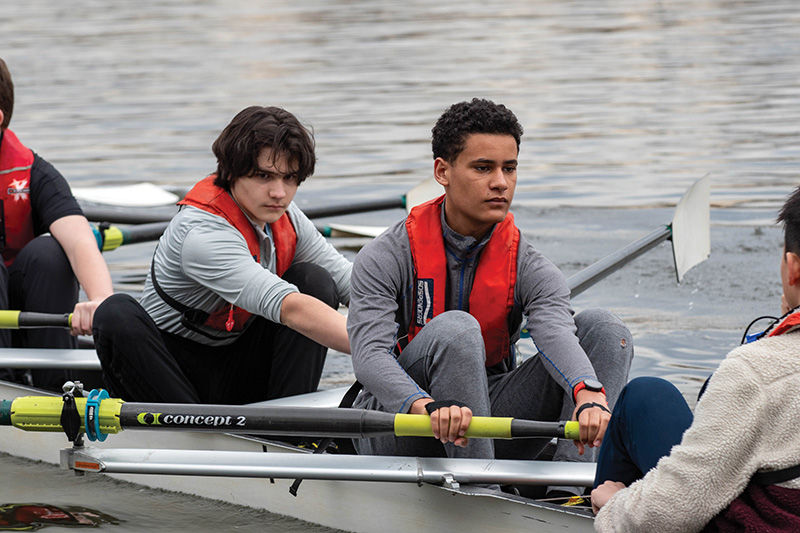 This article appears in the Fall 2025 issue
This article appears in the Fall 2025 issue

Early morning adult program. Riverfront Recapture, March 2023. Image Credit: Andy Hart, courtesy of Riverfront Recapture, Inc.
At Riverfront Recapture, the Row Goes On
By Jennifer LaRue
The late-May morning I arrived at the Greater Hartford Jaycees Community Boathouse on the Connecticut River for my first-ever rowing lesson, I was equal parts apprehensive and ambitious. Having never rowed a stroke in my life, I was eager to learn—and worried I’d be awful at it. But I was determined to jump in with both feet and give it my all.
Which is how I found myself rushing from the parking lot to start scurrying around on the deck with a few dozen rowers, all of them working together energetically to move their long rowboats safely from the boathouse, down the steep ramp to the dock, and into the water. Not wanting to be a laggard, I hustled to join the line of rowers alongside one boat’s hull, watched carefully before mimicking them in reaching my arm across to take hold of the opposite side, and prepared to help carry the vessel to the river.
Just then my old friend Loretta appeared out of the blue. “Jennifer! What are you DOING?”
Loretta, a veteran rower and Riverfront regular, kindly pointed me toward a small circle of people standing outside the boathouse waiting for the first of that session’s Learn to Row classes.
Turns out I had, in my zeal, inserted my silly self among the experienced rowers who make up the recreational rowing teams.
Oops.
Founded in 1981, the nonprofit organization Riverfront Recapture manages, maintains, and operates four riverfront parks and their network of river-walks and trails in Hartford and East Hartford, Connecticut. Its mission is simply “to connect people with the Connecticut River.”

Youth spring rowing program. Riverfront Recapture, 2024. Image Credit: Andy Hart, courtesy of Riverfront Recapture, Inc.
Created in response to the physical—and psychological—separation of the city from its river that resulted from extensive 1940s-era flood-control dikes and the addition of highway I-91 in the late 1950s, Riverfront Recapture has long sought creative ways to bring people back to the river. As Jonathan Near, the organization’s Director of Rowing, puts it, “Hartford’s elevated highway made it hard to even see the river. Our challenge is how do we get people out there to see this asset? How do we reclaim the river and get people out into the parks, whether for a picnic or a program?”
The rowing program has become one of the most successful of those means of engaging people with the river. Based in Riverside Park, just north of downtown Hartford, the Riverfront Recapture Rowing Program launched in 1988 with just two borrowed boats. In the early 1990s, Riverfront Recapture received funds to buy two “eights,” or 8-person boats, for high school rowing. The community programs evolved from the fact that the boats weren’t being used outside of school hours, so adult programs were added to the roster, putting the boats in the water during after-school times. By 2024 more than 28,000 people took part in programs ranging from Learn to Row (LTR) and Recreational Rowing to Adult Racing and the annual Head of the Riverfront regatta each year.
“You can only say so much” to convince people that the river is worth their time and attention, Near notes. “The best way is for folks to come down and give it a try, learn to row.”
One of the program’s earliest visions, Near says, was to provide urban youth with the opportunity to experience rowing. Today the school rowing program pulls from thirty-five public schools, bringing students to the boats rather than the boats to the students. Near observes that rowing is ideal for young people who “want to be athletic, but other sports don’t work for them. Rowing is a place of acceptance. There are no rock stars. You’re working together as a team to get the boat moving smoothly from point A to point B.”
“We believe that rowing can and does change the minds of kids,” Near continues. “They discover something about themselves they might not have known. It’s safe, accepting, and offers potential for growth. If you happen to get some exercise, all the better.”
Near adds that rowing exposes kids to the language peculiar to nautical sports, a shared vocabulary that can help foster pride and ownership. Caring for the delicate, expensive rowboats—one misplaced foot can pierce a hull—offers other opportunities for shared responsibility, he adds. And, he says, the program encourages kids to interact with all kinds of other kids they might not otherwise meet. Near notes that the school rowing program is setting post-COVID records, with seventy-five students participating in Spring 2025 and ninety-five registered for Fall.

Youth spring rowing program. Riverfront Recapture, 2024. Image Credit: Andy Hart, courtesy of Riverfront Recapture, Inc.
From that first day forward, I understood the drill: I knew where to meet my fellow students and our instructor, usually a skilled collegiate rower on summer break, who also would serve as our boat’s coxswain. We got out on the water rain or shine; only when a thunderstorm loomed would we head to the second floor of the boathouse to practice on the “ergs”—the ergonomic rowing machines.
That never happened during my LTR tenure. So for eight mornings, I learned how to row—starting with the proper way to work with my team to remove our shell from its rack, carry it to the dock, and carefully lower it into the water. I learned which seat I was assigned and to step gingerly—and never on the floor of the boat itself—as I found my seat. Fitting my oars in their oarlocks, strapping my feet into the footrests, all became familiar—as did helping to clean the boat and return it, and our oars, to their racks at the end of our session.
I had intended to take more than one session, but life intervened. I got a good introduction but not enough experience for the intricate motions of rowing to become second nature for me, despite the awesome coaching and support from my boatmates. As anyone who’s tried it knows, rowing—in my case, sweeping rather than sculling, as the program recommends for beginners—involves a very specific set of motions, executed in concert with your fellow rowers, all under the direction of the coxswain, whose job is to keep the boat afloat and moving forward.
When you position your body just so, dip your oar in the water at just the right angle, and pull at just the right speed, all in unison with your teammates, it’s a zen moment. But when none of that goes right, as happened to all of us at one time or another, it’s important to remember that rowing, challenging as it can be, is meant to be fun. So you find your smile and keep on trying.
As the four-week program continued, I—who came to rowing without even knowing my port from my starboard, my bow from my stern—fell behind. I worked hard, but while some mornings I managed just fine, other days I just couldn’t master the moves. I worried that I was letting the others down. But you sure wouldn’t know it from the way everyone treated me. I received nothing but kind support, Atta-girl!’s, and sweet offerings of advice from my colleagues.
As for our instructors, they, too, were kind and supportive. But they had a job to do. So, every so often I’d be instructed to perform a stroke over and over until I got it right, my boatmates responsible for holding our vessel steady through the handling of their oars. And while that was challenging, well, that’s how you learn.
In the end, there’s nothing quite like being on the Connecticut River early in the morning, with the new sun picking out details of the Bulkeley Bridge and the Hartford skyline. There’s an egret! There, hulking dinosaur-like across the treeline, goes a blue heron! The water is so clear, you can see the sandy riverbed. The breeze is gentle and chilly and smells divinely of marine life.
Once things settle down, I look forward to getting my butt back in the boat at the riverfront. Maybe this time I’ll remember which side is port and which one is starboard and the motions of rowing will click. But even if not, who cares? I’ll be out on the river, breathing the air, moving my body, and rowing with some of the nicest people I’ve met.
For more information about the Riverfront Recapture Rowing Program—and how you can help keep it afloat—visit https://riverfront.org/rowing/.
